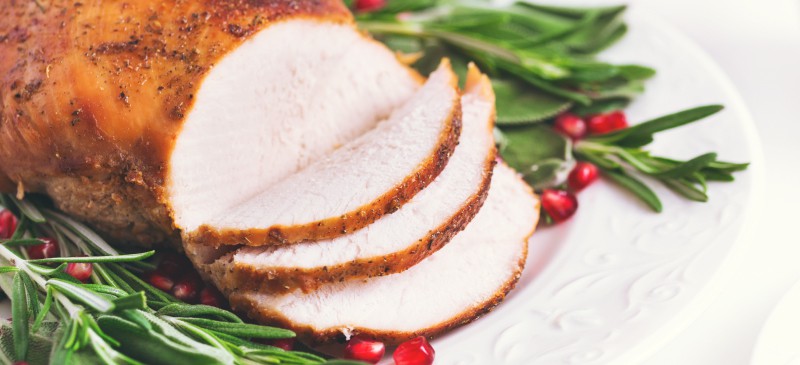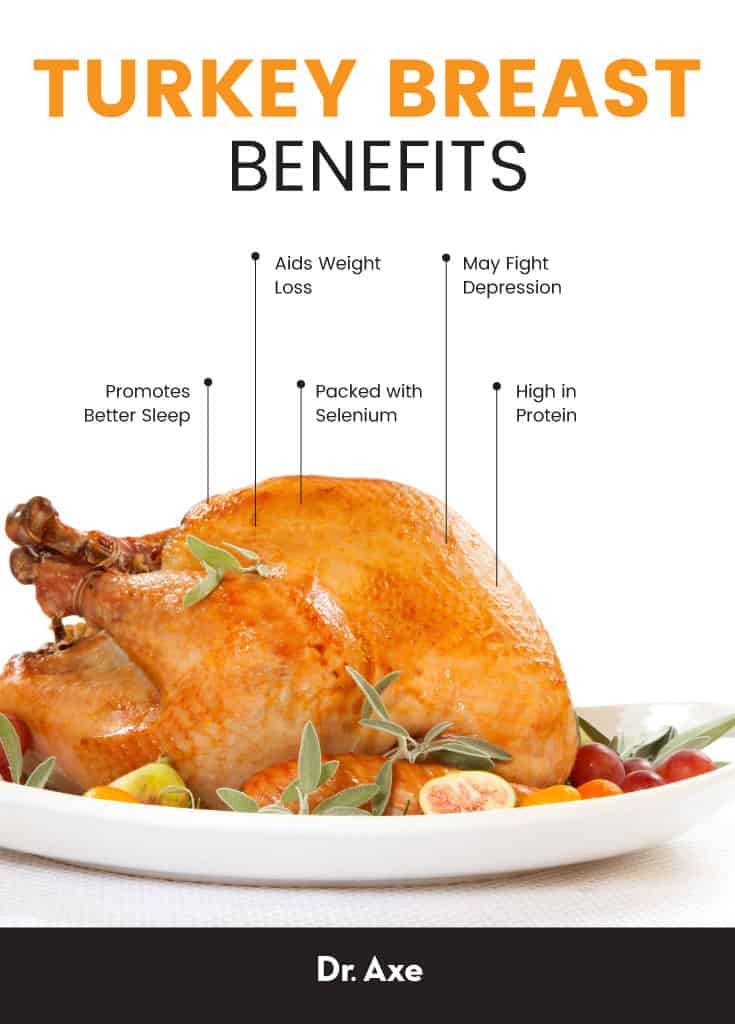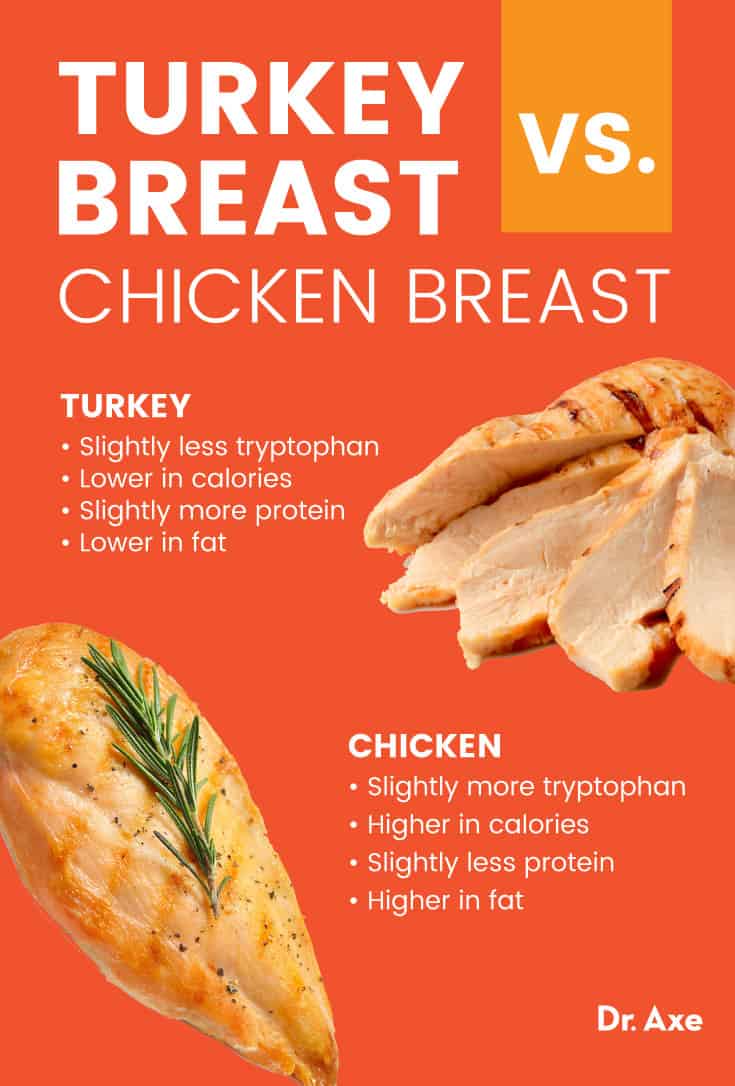
As Thanksgiving rolls around, most of us eagerly await the holiday staples, like pumpkin pie, mashed potatoes and green bean casserole. However, the real star of the show is, of course, the turkey — Thanksgiving just wouldn’t be complete without a big hunk of turkey breast sitting on your plate.
Because of its association with a holiday that encourages eating double your own weight in delicious food, many people wonder: Is turkey bad for you? And is turkey low in cholesterol, or is it loaded with extra fat and calories?
The truth is that turkey is not only delicious, but it’s actually low in calories and fat, plus high in several important nutrients.
If you’re wondering how to cook a turkey breast, how it compares to chicken and why you should incorporate this tasty bird into your diet, keep on reading to find out.
Nutrition Facts
What’s there to admire about turkey nutrition? Most experts consider high-quality poultry meat to be a part of an overall balanced diet aimed at maintaining health.
Turkey is low in calories and carbohydrates but loaded with important nutrients that you require each day — including protein, selenium, phosphorus and riboflavin. It also contains some iron, potassium, zinc, thiamine and vitamin B6.
A three-ounce (85 grams) serving of turkey breast contains approximately:
- 87 calories
- 3.6 grams carbohydrates
- 14.4 grams protein
- 1.5 grams fat
- 0.3 grams fiber
- 19.2 micrograms selenium (27 percent DV)
- 136.2 milligrams phosphorus (15 percent DV)
- 0.3 milligrams riboflavin (15 percent DV)
- 4.8 milligrams vitamin C (9 percent DV)
Health Benefits
1. High in Protein
Turkey is a high-protein food, packing in 14.4 grams per three-ounce serving of turkey breast. It also has less calories and more protein than beef or pork.
We need protein for just about everything. Not only are our hair, skin and nails made up of proteins, but protein also transports oxygen, aids in blood clotting, and repairs and regenerates tissue cells.
Research has shown that adequate protein intake is important for growth, development, maintenance of skeletal muscle tissue, and contributes to physical strength and performance, as well as efficient macronutrient utilization and storage.
Furthermore, getting enough protein in your diet can help keep your weight under control, promote brain and heart health, and even maintain normal blood sugar levels.
2. Can Help Promote Better Sleep
If you’ve ever felt your eyelids drooping after indulging in a turkey feast, there’s a good reason. Turkey is high in tryptophan, an amino acid that helps regulate sleep.
Tryptophan is an essential amino acid that is needed for the biosynthesis of proteins. After consumption, it is metabolically transformed to bioactive metabolites, including serotonin, melatonin and niacin.
Because it’s a precursor to melatonin, a hormone that’s involved in controlling your sleep-wake cycle, increasing your intake of tryptophan has been shown to promote better sleep in multiple studies. It seems to help increase sleepiness and decrease the amount of time it takes to fall asleep, improve sleep quality in those with sleep disturbances like insomnia, reduce awakenings and increase REM sleep.
3. Can Aid in Weight Loss
Poultry is generally low in calories and high in protein, making it a great dietary addition if you’re looking to shed some pounds. A high-protein diet can help reduce levels of ghrelin, a “hunger hormone,” which works to curb cravings and reduce appetite.
Protein has also been shown to help boost metabolism and decrease caloric intake.
According to a 2017 article published in the Journal of Cachexia Sarcopenia and Muscle, in obese patients higher protein intake contributed to “greater weight loss, fat mass loss, better preservation of lean body mass, a more significant reduction of blood pressure, serum triglycerides, and waist circumference” compared to low protein intake when on a restricted diet.
Plus, it takes your body more energy/calories to digest protein than other macronutrients like carbohydrates and fat.

4. Packed with Selenium
Turkey is a good source of selenium, supplying 27 percent of your daily selenium requirement in each three-ounce serving. This mineral plays a central role in many aspects of health.
Selenium benefits your metabolism, increases immunity, and acts as an antioxidant to protect against free radical damage and inflammation.
This important mineral has also been shown to have anticancer properties and has even been associated with a decreased risk of coronary heart disease.
5. May Help Improve Your Mood and Fight Depression
Thanks to its high tryptophan content, poultry may also aid in the treatment of conditions like depression.
This is because tryptophan is able to boost the production of serotonin, a neurotransmitter that is found in the brain, digestive tract and blood platelets. Serotonin is thought to control mood balance, and a deficit has been linked to a higher risk of depression.
READ RELATED: Teen Creates 3D-Printed Lunch Tray for Special Needs Students, Wins STEM Award
In one study, tryptophan depletion was shown to significantly lower moods in healthy women. A review published in the Cochrane Database of Systematic Reviews also demonstrated that tryptophan was more effective at treating depression than a placebo, although researchers noted that more evidence is needed.
And a 2020 systematic review concluded that higher tryptophan intake may be an effective approach to decrease anxiety and increase positive mood in healthy individuals.
How to Cook a Turkey Breast
When shopping for a turkey, keep in mind that fresh birds offer more flavor, but frozen ones are typically a better value for your money. Frozen birds can also be convenient if you’re shopping ahead of time and have time to spare to thaw it out before cooking.
Although turkeys are widely available at most grocery stores, the quality and taste can vary depending on the brand. Ideally, look for free-range, organic turkey and one that is antibiotic-free to ensure you get the best quality.
How much do you need to feed a crowd? Generally, it’s recommended to get at least one pound of turkey per person — or 1.5 pounds each if you hope to have some leftovers in your fridge for later.
Once you have your turkey, it’s time to fire up the oven and get cooking. Here’s how to cook a turkey that will go great with your next holiday meal:
- If using one’s that frozen, start by thawing in the refrigerator or covering in cold water to unfreeze.
- Next, remove the giblets from the inside. You can save these for later and use to make gravy or stuffing.
- Rinse both the inside and out, then pat dry with a paper towel.
- Stuff loosely (if desired) by allotting between 1/2–3/4 cup of stuffing for each pound.
- Next, truss the bird by using a string to tie the drumsticks together.
- Use a brush to coat the skin with oil or melted butter.
- Insert a meat thermometer into the thickest part of the thigh to monitor the temperature. Be sure that the thermometer is pointing toward the body and is not touching the bone.
- Put the bird on a roasting pan and place in an oven preheated to 350 degrees Fahrenheit.
- Allow to roast until the skin has turned golden, then cover with foil to keep it from browning further. Uncover during the last 45 minutes of cooking to finish browning the skin.
Here are some frequently asked questions regarding how to cook a turkey breast:
How do you keep a turkey breast from drying out?
Tie the legs together, cover it with foil and oil the skin before cooking. Once it’s done cooking, let it sit for about 30 minutes before cutting it into it, which helps it absorb its juices and stay moist.
How long do you cook turkey breast?
The general turkey breast cooking time per pound is about 20 minutes, though that can vary based on whether or not your turkey is stuffed.
Do you cook a turkey at 325 or 350?
350 degrees Fahrenheit.
Should a turkey breast be cooked covered or uncovered?
Both. Allow to roast until the skin has turned golden, then cover with foil to keep it from browning further
How do you tell if a turkey breast is done?
It should be done cooking when the temperature has reached at least 180 degrees Fahrenheit in the thigh and 165 degrees Fahrenheit in the breast and/or stuffing.

Parts to Eat
People have differing opinions on which part of the turkey is best in terms of taste. Some prefer white meat found in the breast and wings while others enjoy the rich flavor of dark meat in the legs and thighs.
There are minute differences between dark and white meat nutritionally, but these are mostly negligible. Although dark meat typically contains slightly more calories, cholesterol and fat than white meat, it’s also higher in iron, zinc and B vitamins.
If you’re looking to cut calories and fat, be sure to opt for skinless turkey whenever possible. This part of the turkey is higher in calories and fat but low in the nutrients you’ll find in the other areas of the turkey.
The American Heart Association recommends sticking to a portion of meat that is two to three ounces or about the size of a deck of cards and choosing lean cuts of meat if fat intake is a concern for you.
Additionally, note that there are some slight differences in terms of nutrition for other forms of turkey, like ground or sliced turkey. Ground turkey can contain both white and dark meat, and the ground turkey nutrition facts can vary based on fat content.
Sliced turkey nutrition, on the other hand, tends to be high in sodium, which is added to extend shelf life. Although the calories in lunch meat are comparable, it’s best to stick to fresh or ground whenever possible to get the most nutritional bang for your buck.
Related: How to Carve a Turkey: Step-by-Step Guide (Plus Recipes!)
Turkey Breast vs. Chicken Breast
Turkey and chicken are by far the two most popular types of poultry, loved for their distinct flavors as well as the convenience and nutrients that they offer. So is it better to eat turkey or chicken every day?
In comparing turkey breast vs. chicken breast, turkey contains slightly less tryptophan than chicken but is also lower in calories. Turkey breast protein is also just slightly higher than chicken, and it also tends to be lower in fat.
However, although turkey does have a slight edge over chicken in several aspects, the differences between these two types of poultry are very minor. Both can be healthy and nutritious ways to boost protein intake each day and squeeze in some important vitamins and minerals.
If you do decide to go with chicken, opt for organic, free-range chicken to prevent disruptions in hormone levels and adverse effects on your health.

Recipes
Now that you know how to find and cook a great-tasting turkey, here are a few healthy recipe ideas to get you started:
Plus, make sure to check out these leftover turkey recipes to put your leftovers to good use.
Risks and Side Effects
Although uncommon, some people may experience an allergic reaction in response to poultry. Additionally, some people may have a sensitivity or allergy to certain additives found in processed meat products.
Food allergy symptoms include hives, congestion, sneezing, headaches, asthma and nausea. If you experience these or any other negative side effects after eating poultry, discontinue use and talk to your doctor.
Finally, keep in mind that processed meat products, like deli meat, tend to be high in sodium. If you’re watching your sodium intake, look for a low-sodium variety, or better yet, go for fresh or ground meat.
Conclusion
- Turkey breast supplies important nutrients that you require each day, including protein, selenium, phosphorus and riboflavin. It’s also high in tryptophan, an amino acid that could help promote better sleep and fight depression.
- Benefits of this type of poultry include being high in protein, promoting good sleep, helping with weight loss and supporting a positive mood.
- The differences between white and dark meat are negligible, but be sure to opt for skinless if you’re watching your calorie and fat intake.
- Compared to chicken, turkey is slightly lower in calories and fat but higher in protein. Still, both can be nutritious additions to a healthy and well-balanced diet.
- Finally, go for fresh turkey instead of processed turkey to minimize sodium intake, and be sure to cook to a minimum temperature of 165 degrees Fahrenheit to prevent foodborne illness.
Source: Dr. Axe | Nutrition






